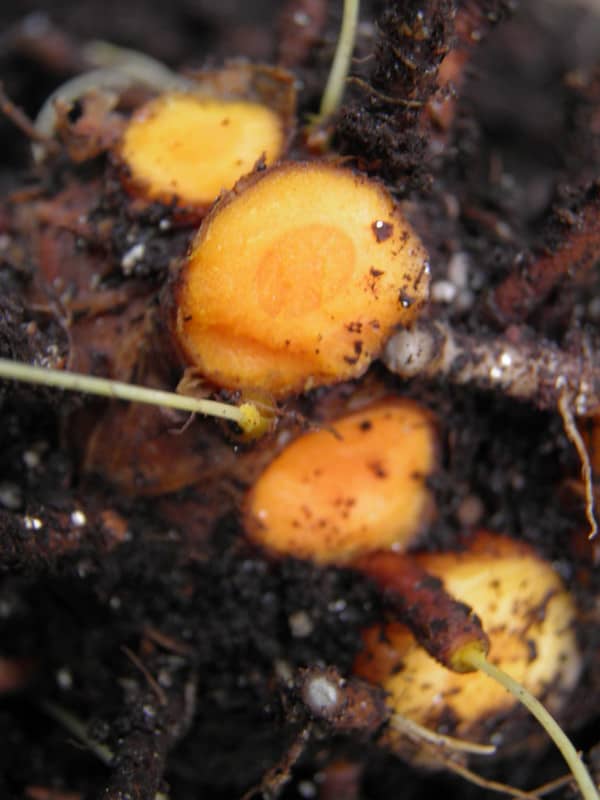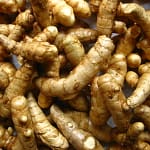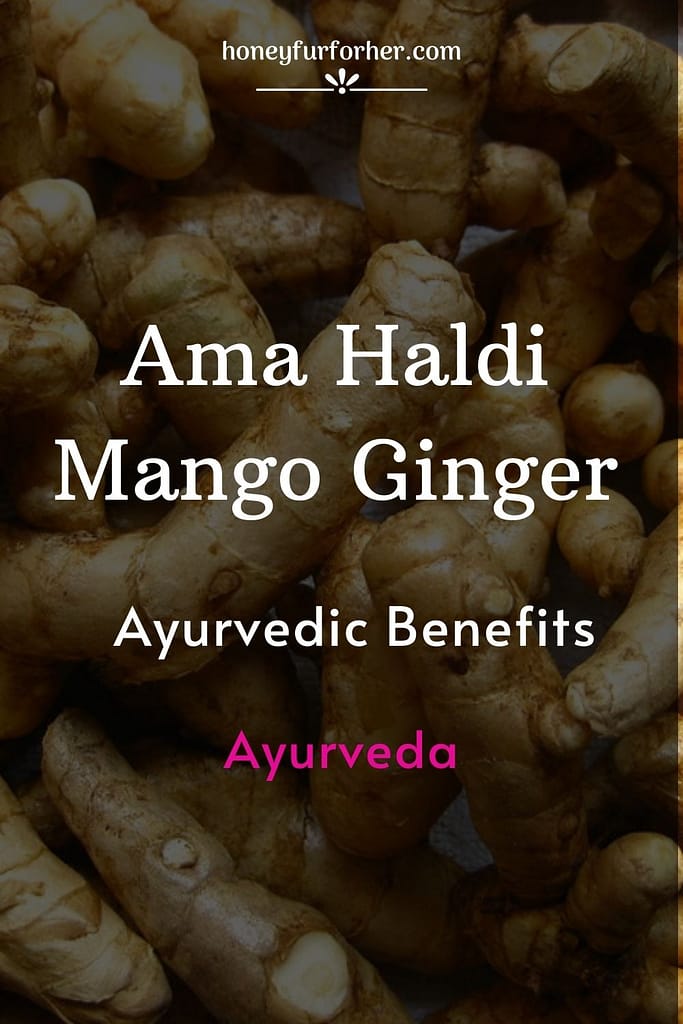Amba Haldi (Curcuma Amada) is an Ayurvedic herb popularity known as Mango Ginger. It is commonly used for treatment of various pruritus (skin conditions with itching).
Ama Haldi also finds its use for culinary purposes. It is also used in making pickles in southern India and chutneys in the northern region. It is a popular spice and vegetable due to its rich flavour, sweet with subtle earthly floral and pepper overtones. It adds a delicious taste to salads and stir fries. It is very commonly used in South asian and southeast Asian as well as Far East Asian cuisines.
It is also known as white turmeric, naturally grows in the Indian Himalayas and is cultivated throughout India, Bangladesh, Sri-Lanka and in many South-Eastern countries for its medicinal properties. It grows only during monsoon season. The tubers of the plant, when fresh have a similar odour to mango which gives it its English name; Mango ginger.

It contains Carbohydrates, saponins, glycosides, phytosterols, resins, flavonoids, Curcumin, vitamin A, proteins, fats and minerals.
Amba Haldi Other Names
Sanskrit Names: Darvidbheda, Amragandha, Surabhidaru, Daru, Karpura, Padmapatra, Surabhi, Suranayaka
Latin Name: Curcuma Amada Roxb
Family: Zingiberaceae
Hindi name: Ama Haldi (अामा हल्दी), Karpura Haldi, Amba Haldi, Amiya Haldi (अामिया हल्दी)
English: Mango Ginger
Bengali Name: Amada (अामडा)
Urdu Name: Amba Haldi
Ayurvedic Classical Reference
दार्विभेदाअम्रगन्धाचसुरभीदारूदारूच॥
कर्पूरापद्मपत्रा स्यतसुरभीसुरनायका।
आम्रगन्धिर्हरिद्रायासाशीतावातलामता॥
पित्तह्रि्न्मधुरातित्त्कासर्वकण्ङूविनाशिनि।
Bhavprakash Nighantu (Haritayadivargah)
The above shloka says that alternate names for the herb are Darvibheda, Amragandha, Surabhidaru, Daru, Karpura, Padmaptra, Surabhi and Suranayaka. Amragandhiharidra (amba haldi) is cold in potency, aggravates vata dosha, and pacifies pitta and kapha dosha. It is sweet and bitter in taste and is useful in all types of pruritus.
Beneficial Properties
1. Antiseptic
2. Anti- inflammatory
3. Antimicrobial
4. Anthelmintic
3. Antioxidant
4. Anti-Aging properties
5. Carminative
6. Stomachic
7. Digestive
The properties as well as appearance are known to be similar to adhraka (ginger).

Different Species Of Haldi And Difference Between Them
Species | Curcuma Longa | Curcuma Caesia | Curcuma Amada | Curcuma Aromatica |
Common Name (Hindi) | Haldi | Kali Haldi , Krishna Haldi, Jayanti | Amba Haldi | Kasturi Haldi, Kasturi Manjal, Banahaldi, Banaharadi, Jungli Haldi |
Common Name (English) | Turmeric | Black Zedoary | Mango Ginger, White Turmeric | Wild Turmeric, Yellow Zedoary, Cochin Turmeric |
Colour | Rhizome are orangish yellow, golden colour. It stains immediately. | Black | Pale yellow / lemon yellow | Orange Yellow |
Curcumin Content | Depends on the region its collected from. The one found in India is ranging from 0.12% (Kerala) to 6-8 - 7.3% (Lakadong Meghalaya). You can read chart here | None | Very little to none | Ranging from 0.03 mg to 5mg per 100mg of Rhizome. |
Medicinal Value | Promotes complexion of skin, Useful in skin diseases, Blood related diseases, diabetes, anaemia, swelling and wounds. | Sprains and Bruises, Cosmetic products | Used to treat anorexia, dyspepsia, flatulence, colic, bruises wounds, chronic ulcers, skin diseases, pruritus, fever, constipations, hiccough, cough, bronchitis, sprains, gout, halitosis, and inflammations | Used in blood and skin disorders. Cannot be used as a condiment. |
Properties | Hepatoprotective, | Antioxidant, | Carminative, Stomachic. Digestive, Astringent, | Anticancer, Antidiabetic, Antioxidant, anti-inflammatory, antimicrobial, antitussive, antiepileptic, analgesic, wound healing, and insect repellent activitie |
Phytochemicals | Protein, Steroids, Flavonoid | Carbohydrate, Protein, Steroids, Glycoside, Flavonoid, | Carbohydrate, Protein, Steroids, Glycoside, Alkaloid | Alkaloids, terpenoids, flavonoids, steroids, saponins, tannins, phenols, phytosterols, glycosides, protein amino acids, and volatile oils |
Common uses other than medicinal | Dying purposes in domestic use. Used in cooking as a spice. | Mainly used for culinary preparations eg preserves, candy, pickle, sauce. Also used for manufacturing oleoresin and essential oils. |
Difference between Amba Haldi and Normal Haldi
Yellow turmeric or Haldi is most commonly found in the South of India and is the root of plant curcuma Longa. It is brownish yellow on the outside and orange on the inside due to high Curcumin content.
Amba Haldi is brighter than yellow turmeric and tastes bitterer as well.
One of the main difference between the two is that amba haldi stains less as compared to the yellow Haldi. While haldi is hot in nature and aggravates vata and kapha, amba haldi is cooling and pacifies pitta and kapha and aggravates vata.
Difference between Amba Haldi and Kasturi Manjal / Wild Turmeric
Both are different varieties of turmeric. Wild turmeric is Curcuma aromatica while Amba haldi is Curcuma amada. Check the table above for more details.
The main difference between Kasturi Manjal and Amba Haldi is that it does not stain. It is also very fragrant as compared to Amba Haldi.
Ayurvedic Properties
1. Sheetala: Used as a coolant
2. Vrushya: Aphrodisiac, improves vigor
3. Sannipata: Useful in balancing tridosha imbalance disorders.
4. Kanduhara: Useful in relieving pruritus (itching)
Medicinal Benefits
Amba Haldi For Weight Loss and Cholesterol
Due to its digestive nature and kapha balancing property. It is also effective in digesting accumulated Ama dosha, as well as reduces pitta. Due to these it is great for managing obesity and high cholesterol levels.
Studies conducted on rats conclude mango ginger as having a good anti-hypercholesterolemic activity in hypercholesterolemic situation.
Amba Haldi For Bones & Arthritis
The rhizome contains a good amount of Magnesium, which works as an antioxidant and helps develop bones and heals wounds by increasing collagen production. A deficiency of magnesium causes disorder of bony cartilaginous growth in infants and children and may lead to immunodeficiency disorder and rheumatic arthritis in adults. The paste of rhizome with spirit and egg white is used to apply on chronic rheumatism and bruises for quick healing.
Specifically in arthritis, mango ginger is used to create a paste in combination with Moringa bark decoction (evaporated so that a paste is left) and black pepper powder. It is directly applied over joints for relief in pain.
In Uttar Pradesh, amba haldi is used for healing bone fractures. It is said that if the poultice of Maida leaf (Litsea glutinosa) and Ama haldi is tide over bone fractureafter setting the bone by an orthopedic and taken orally also, the pain and inflammation reduces considerably and the fracture heals within a very short span of time.
In Meena community of Rajasthan, the rhizome was traditionally given to cattle by mixing it with food to help heal bone fractures quickly.
Amba Haldi Benefits For Acne, dark circles, dark spots, Pigmentation & Skin Care
Ayurveda considers the rhizome to be a great medicine for skin related diseases of all kinds. The essential oil extracted from curcuma amda shows strong antifungal and anti inflammatory activity which proves as a great remedy for skin diseases. High antioxidant and pitta pacifying properties of the herb fight age and pitta related problems like dark spots, blemishes and wrinkles.
Traditionally dry rhizome powder is applied as a face pack to cure acne, blemishes. Ayurveda recommends using haldi, ama haldi, manjistha, and priyangu for applying on facial skin to cure acne, pimples, dark spots, shadows, dark circles and wrinkles.
Apart from facial skin problems, it also fights infectious skin diseases. The rhizome and the peels of ama haldi shows a great antibacterial and antimicrobial property against Staphylococcus Aureus (common cause of absesses, skin infections, respiratory infections, food poisioning), Escherichia coli and Bacillus Subtilis bacteria. The essential oil shows anti fungal activity towards some plant and human pathogens like Candida Albicans, Epidermophyton, Floccosum, Trichophyton rubrum, Aspergillus niger, A flavus, Penicillium notatum, Rhizompus sp., Mucor species. It is also used traditionally to cure problems like eczema.
Amba Haldi For Sprain, Wounds, Joint & Knee Pain
It is considered a great herb for healing wounds which are internal or external. The swelling and pain associated with sprains, minor contusions and injuries can be dealt by the external application of the paste of the rhizome along with raktabola / kala gond. It can be applied directly without mixing raktabola as well. It works as a good pain killer and its high curcumin content reduces inflammation and can be used for localised pain over the joints as well.
Amba Haldi For Hair
The herb commonly used to improve the health of the hair. Amba Haldi powder strengthens the hair follicles and stimulates healthy hair growth. Due to anti-inflammatory properties of Amba Haldi it also soothes scalp irritation and reduces itching. It also reduces dryness and provides depth nourishment and reduces flakiness of the scalp.
Usage: Mix 2gms rhizome powder with 1 ml of water to form a paste. Apply the paste from roots to tips and leave for 10 minutes. Rinse thoroughly with water and use mild shampoo.
Amba Haldi For Stomach Digestive Issues
The herb is useful for indigestion as well and allows you to maintain a good gastrointestinal health. It has therapeutic effects in gastric complaints like abdominal gas.
Studies have found that the fresh juice of the rhizome of curcuma amada has a strong antiulcer property and can be used to treat the same.
2-3 gms of the powder of the dry rhizome of is added to a glass of buttermilk to treat conditions of indigestion.
Amba Haldi For Cough and Respiratory Diseases
5-10 ml of the fresh juice of rhizome mixed with few drops of honey is considered as the best remedy for cough and asthma. Regular usage of white turmeric will help clean lungs and nasal passage.
Intestinal Worms
A study analysed the effect of different extracts (Petroleum ether, Dichloromethane, Ethanol and Aqueous) of C. Caesia and C. Amada on mortality time of test parasite. Both the species were found to be active with regard to both paralysis and death times.
Dose dependent anthelmintic activity was observed against earthworms. Both ethanol extract (150 mg/ml) and dichloromethane extract (150mg/ml) of Curcuma caesia and Curcuma amada (150 mg/ml) were very effective in causing death of earthworms.
As a remedy, the juice extracted from the rhizome of Amba Haldi in dose of 10 ml is consumed to treat intestinal worms.
Dosage Information
Dried rhizome powder: 3-5grams
Fresh juice: 10-20ml
Possible Side effects
- No known side effects are known associated with the use of the plant.
- Does not react with homeopathic medicines.
- Can be continued while taking supplements such as multivitamins, Omega 3 and fatty acids. In case you are taking more than one product per day you can consult your doctor.
Consult a doctor while taking this product along with other western medicines. Usually it is advised to take allopathic medicine first and then wait for 30 minutes before taking Ayurvedic medicines.
Price & Availability
Amazon
VY VedaYug Amba haldi Powder (200 gms): Rs. 259
Paryagat Amba Haldi powder (100gms): Rs. 499
Alps goodness Amba Haldi Powder (250) : Rs 287
Did you find this post useful? Would you like to get back to it later? Save THIS PIN below to your Pinterest Natural Living or Ayurveda board!


Is Amba Haldi a hybrid like turmeric or is it indigenous ?
Hi Thurston,
Amba Haldi is not a hybrid but an indigenous herb. It is a different variety of Turmeric altogether.
Regards,
Swati